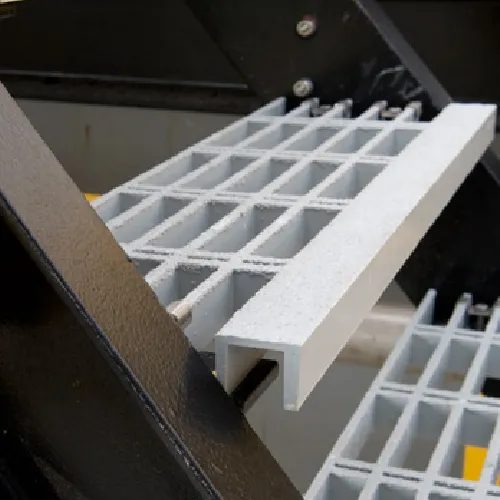loading...
- No. 9, Xingyuan South Street, Dongwaihuan Road, Zaoqiang County, Hengshui, Hebei, China
- admin@zjcomposites.com
- +86 15097380338
- Welcome to visit our website!
Innovative Applications of Structural Fiberglass Reinforced Polymer in Modern Construction
The Role of Structural FRP Fiberglass in Modern Construction
In recent years, the construction industry has been revolutionized by the introduction and application of advanced materials, among which Fiber Reinforced Polymer (FRP), particularly fiberglass, has gained considerable prominence. Structural FRP fiberglass is a composite material, combining the high tensile strength of glass fibers with the lightweight properties of polymers, making it an ideal choice for various construction applications. This article explores its composition, benefits, applications, and future prospects in the realm of modern architecture and infrastructure.
Composition of FRP Fiberglass
FRP fiberglass consists of a polymer matrix (usually epoxy or vinyl ester) reinforced with glass fibers. The glass fibers provide the material with exceptional strength and rigidity, while the polymer component ensures flexibility and resistance to environmental degradation. This unique combination allows FRP fiberglass to withstand demanding conditions while maintaining a lightweight profile. The production process typically involves the layering of glass fibers within the resin matrix, resulting in a highly durable and corrosion-resistant material.
Benefits of Structural FRP Fiberglass
One of the most significant advantages of structural FRP fiberglass is its impressive strength-to-weight ratio. Compared to traditional materials such as steel or concrete, fiberglass is considerably lighter, which can lead to reduced transportation costs and easier handling during installation. Additionally, the corrosion resistance of fiberglass makes it suitable for use in harsh environments, including coastal areas and industrial settings where chemical exposure is common.
Moreover, FRP fiberglass is non-conductive and non-magnetic, making it ideal for applications in electrical and telecommunications sectors. The ease of customization and versatility of fiberglass also allows for innovative architectural designs without compromising structural integrity. This adaptability is increasingly sought after in a world that values aesthetically pleasing yet functional structures.
Applications in Modern Construction
structural frp fiberglass

The applications of structural FRP fiberglass are diverse and continue to expand as the technology advances. In civil engineering, it is utilized in bridge construction, where the lightweight properties contribute to efficient installation and reduced load on supporting structures. FRP composite materials are also increasingly being used to reinforce existing structures, offering a solution for increasing load capacity and extending the lifespan of aging buildings and bridges without significant modifications.
In the field of architecture, FRP fiberglass allows designers to experiment with forms and shapes that would be difficult or impossible with traditional materials. Its application can be seen in facades, roofing systems, and even furniture design, where both aesthetic value and structural performance are essential. Furthermore, the use of fiberglass in sustainable building practices is noteworthy, as it can enhance energy efficiency and reduce overall construction waste.
Challenges and Future Prospects
Despite its many advantages, there are challenges to the widespread adoption of structural FRP fiberglass. The initial cost of materials can be higher than traditional options, which may deter some builders. Additionally, the long-term performance and recyclability of FRP materials are still under evaluation. As the industry continues to evolve, advancements in manufacturing processes and material science are likely to reduce costs and improve the sustainability of FRP fiberglass.
Looking ahead, the future of structural FRP fiberglass in construction appears promising. As the demand for sustainable and durable construction materials grows, the versatility and performance of fiberglass composites can meet these needs effectively. Ongoing research into improving the properties of FRP materials, coupled with increased awareness of their benefits, will likely lead to broader applications and acceptance in various construction projects around the globe.
Conclusion
In summary, structural FRP fiberglass is a transformative material that is reshaping the construction landscape. Its unique combination of strength, lightweight properties, and resistance to environmental factors makes it an attractive option for modern construction applications. As technology progresses and the industry embraces innovation, the potential of FRP fiberglass will undoubtedly play a crucial role in the future of architecture and infrastructure, paving the way for more resilient and sustainable building practices.
-
The Rise of FRP Profiles: Strong, Lightweight, and Built to LastNewsJul.14,2025
-
SMC Panel Tanks: A Modern Water Storage Solution for All EnvironmentsNewsJul.14,2025
-
GRP Grating: A Modern Solution for Safe and Durable Access SystemsNewsJul.14,2025
-
Galvanized Steel Water Tanks: Durable, Reliable, and Ready for UseNewsJul.14,2025
-
FRP Mini Mesh Grating: The Safer, Smarter Flooring SolutionNewsJul.14,2025
-
Exploring FRP Vessels: Durable Solutions for Modern Fluid HandlingNewsJul.14,2025
-
GRP Structures: The Future of Lightweight, High-Performance EngineeringNewsJun.20,2025
